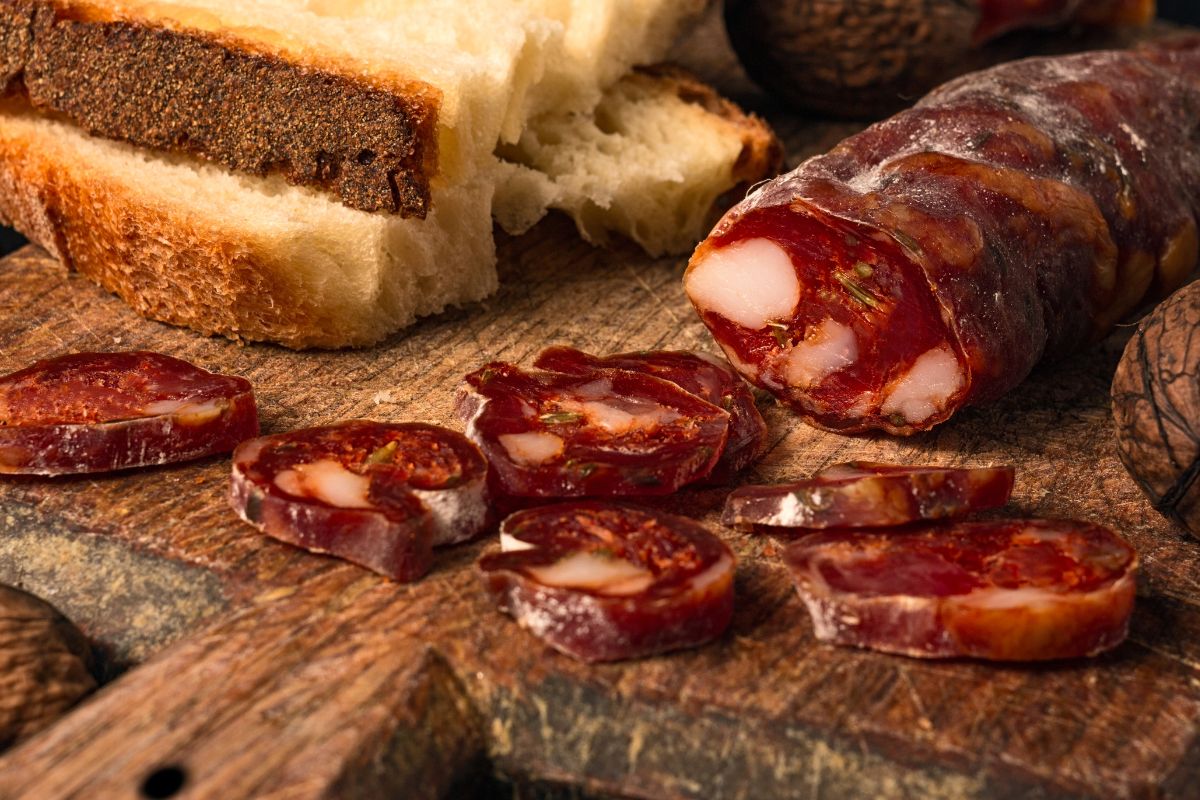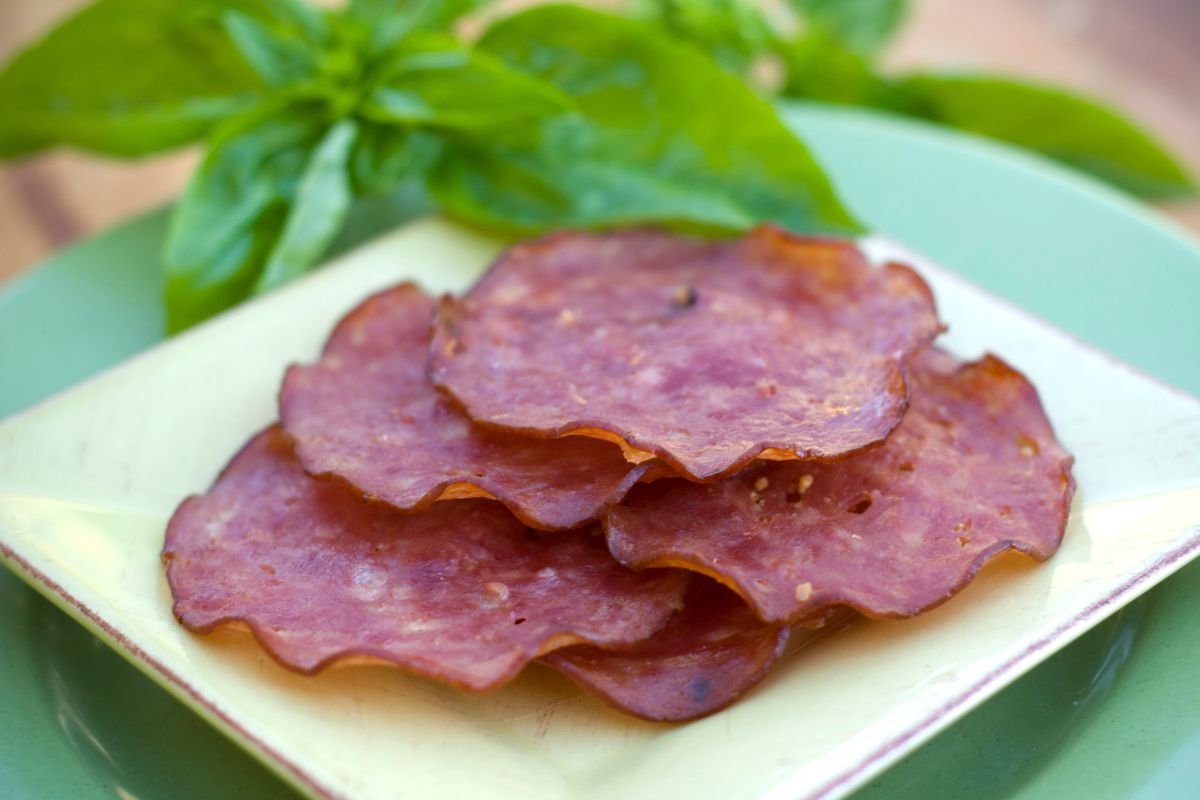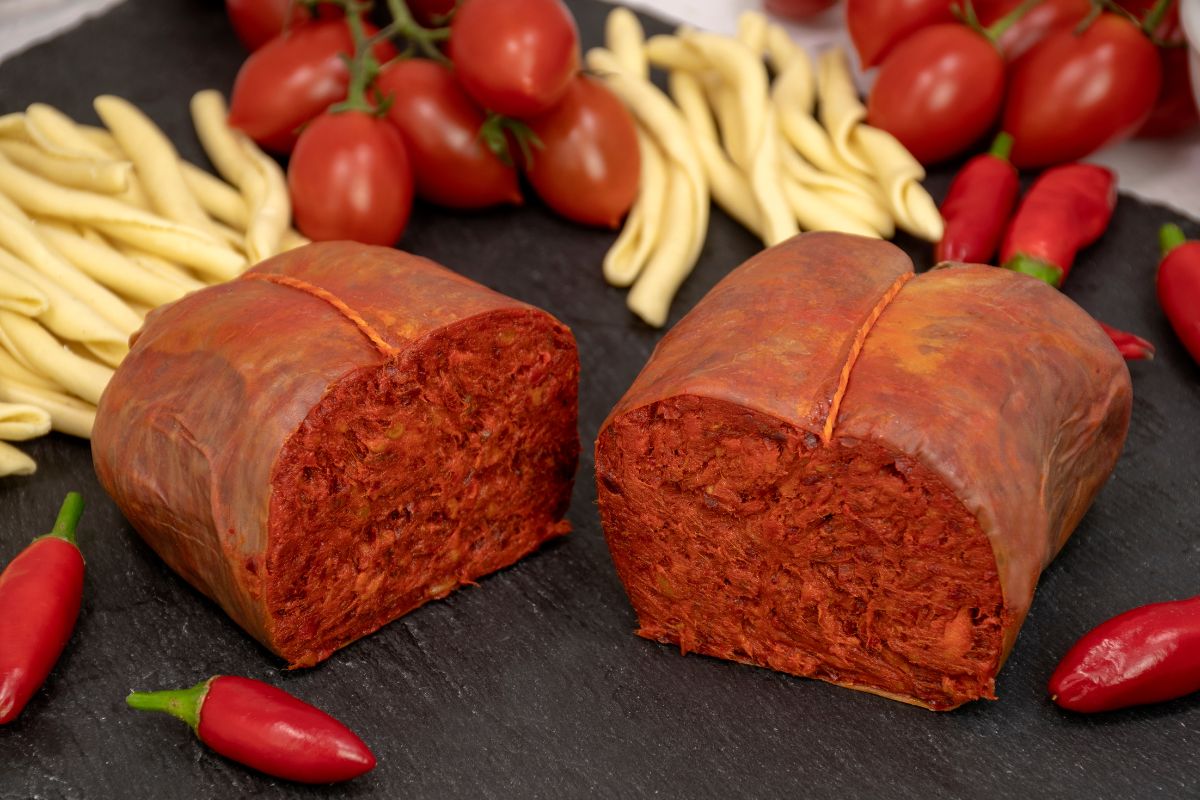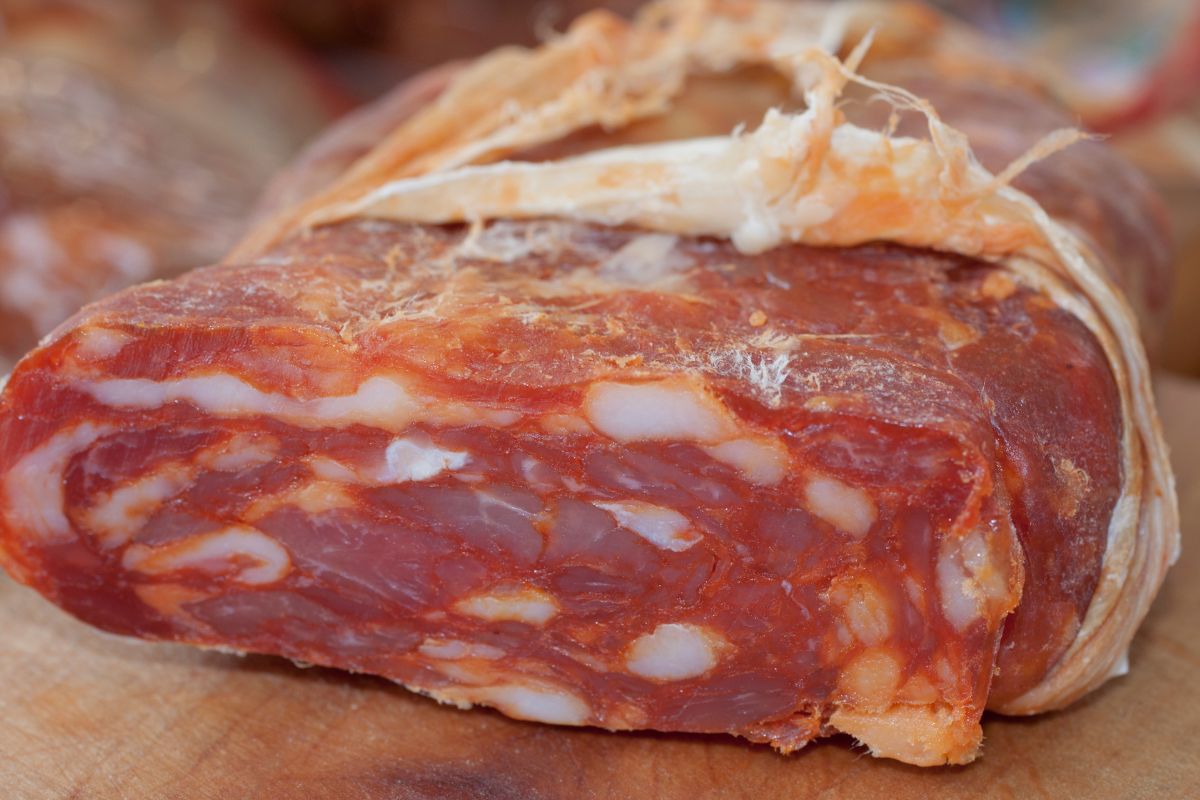What is Italian Sausage?
What is Italian sausage? These are types of Italian sausages with many flavors; one can season them with dry and fresh herbs. Italian sausage is a name used in the US to refer to pork sausage with fennel seeds or anise. Most people label the Italian sausage spicy with a dash of red pepper for extra heat.

What is Italian Sausage Made of?
What is Italian sausage made of? Different ingredients for making Italian sausages.
Meat
There are different types of meat with high-fat content for making Italian sausages, Most sausages use ground pork, but you can use turkey, lamb, or ground beef as substitutes.
Wine
White or red wine is among the best sausage ingredients for adding flavor, and it is a great supplement to Italian sausages. You can use wine to marinate the meat or simmer it in a pot to make the sausage juicier.
Sausage Casing
You use the sausage casing to place the meat and give it a distinct sausage appearance. It is important to soak the sausage casings at room temperature water for 60 minutes or more.
You should take out casing which leaks and use the perfect ones. Keeping the mixture in the casing is tedious but also a fun experience.
Vegetables
You use vegetables to add more filling to Italian sausages. You can use celery or crushed bell pepper or combine the mixture with meat which elevates and adds more variety to the flavor.
What Do Italian Sausages Taste Like?
The taste of Italian salamis or sausages depends on the ingredients and the seasoning process. Some may be mild, hot, or sweet, depending on the spices you use to season. To have a tasty hot sausage, you can season it with chili peppers; for tasty sweet basil, you can season it with basil.
The Different Types of Italian Sausage
There are different types of Italian sausages and salamis, such as
Finocchiona
Finocchiona is a finely ground salami pork’s neck and shoulder, rump, lean belly, flank, ham trimming, and collar originating from Tuscany. Finocchiona’s name comes from a typical Tuscan salami, finocchio, meaning fennel. Most people believe mild fennel has a stronger flavor.
The unusual ingredient for finocchiona salami is fennel which gives it a sweet intriguing anise-like taste. You can season your finocchiona with salt, pepper, garlic, and peppercorns.
There is an Italian culinary tradition of cured meat, where you ground the pork and stuff it into salamis to cure the fiocchiona for it to be firm and dry.
You can give your finocchiona a long or shorter cure.
Shorter-Cure
A shorter cure is also known as finocchiona sbriciolona, a more fresh and crumbly salami that reminds consumers more of sausages than salamis. The ground pork for making shorter finocchiona is chunky and facilitates a crumbly end product. People mostly enjoy serving shorter cure finocchiona with hearty artisan bread or a thick wedge.
Long-Cure Finocchiona
Long-cure finocchiona is firm and dry with a texture and consistency similar to salami. You should slice its end product for pasta sauces, antipasto alla Toscano, and other meals. Like other cured meats, long-cure finocchiona has a layered flavor, is salty with a complex, and is suitable to serve with hearty wines and strong cheese.
Finocchiona’s unique flavor makes it a treat for other parts of Italy and worldwide. Finocchio is mostly an appetizer and has a fennel seed aroma or flowers if used in the mince.
Genoa salami
This traditional Italian dry sausage from genoa and its surrounding area combines pork, garlic, peppercorns, salt, and red wine. Some producers choose to add veal or beef instead of pork salami.
Peppercorns create an explosion spice end product. There are two types of peppercorns.
White peppercorn: You can use it to make Genoa salami.
Black peppercorn: You can use it in stud Cotto salami.
Genoa salami is not cooked but cured, making it have a fermented flavor and safe to eat. It has a moist, soft, and slightly greasy texture with a rich, sharp, and tangy flavor.
Genoa salami stays at room temperature; most people use it on sandwiches, salads, or mozzarella. It also pairs well with chewy bread, antipasto platters, and mild or creamy cheeses.
Pick a firm specimen without soft spots or slime when selecting the best genoa salami in a store.
A small amount of white mold on the outside is acceptable, but you should scrape it before eating.

Mortadella Bologna
Mortadella Bologna is a traditional Italian pork sausage from Bologna Felisina, the Etruscan city. To make mortadella bologna, grind and mash it to a paste using a mortar. Additionally, cubes of fat from pigs throat, known as lardeni, and several spices, such as coriander and pepper, make the cured Italian mortadella bologna sausage.
It would help if you cooked the mortadella for several hours at a low temperature with low humidity. After baking, refrigerate it and store it for up to eight months.
In the US, they prefer the mortadella sliced thick as bologna, while in Italy, they prefer it very thinly sliced. Each mortadella slice contains approximately 9% saturated fat, but on average, it has 28%fat content.
It is best to serve mortadella at room temperature to bring out its rich flavor, whether thinly sliced or cut into cubes.
Nduja
Nduja is a chili-spiced, spreadable pork salami and delicacy from Calabria, Italy. Nduja is a cured salami with a texture similar to pâté.
Nduja has a spicy, hot, and addictive taste, and there are several ways to enjoy nduja, such as spreading it on grilled. Searing meat and fish, roasting, adding to egg-based dishes and pasta sauces, fresh ricotta or burrata cheese.
Hot chili works as a preservative keeping the meat safe for several months. Nduja is a piquant treat for people who like their food punchy.

Pistol (Lombardy)
The pistol originates from mantua province and is very similar to cotechino. The pistol comes from leftover salamis; today, it’s known as Prodotto Agroalimentare Tradizionale of the Lombardy region.
Pistol is a soft sausage from ground pork meat, salt, pepper, pancetta, wine, and garlic. The pistol is enjoyable when you serve it with polenta, but you can use it for seasoning in local risotto recipes like risotto alla pilota and traditional local dishes.
Patina
Patina is a type of smoked sausage originating from the Pordenone province. Patina comes from a paste that contains lean meat such as goat, sheep, red deer, roe deer, fallow deer, and chamois, and fat from pork belly or shoulder.
You season the meat and fat with rock salt, sea salt, black pepper, red wine, and aromatic herbs. You shape the mixture into balls and roll them in maize flour for preservation, and then you smoke them over an embed of juniper wood and leave them to age.
You cut the patina to lean with a fine grain; it has a smoky aroma and rich and full-bodied flavor. Some people use a combination of goat, pork, beef, and mutton to add fat and soften the texture, and mushrooms or truffles to add extra flavor.
Salame Napoli
Salame Napoli is an Italian salami in various sizes throughout the Campania region. Salame comes from pork shoulder, neck, ham, leg, and loin; you can use black pepper and other spices to season it.
To make the salame Napoli, place the combination into a natural pig intestine casing and allow it to dry and age to a salami’s size. Dying and aging take less than 30 days.
Salame Napoli has a dense and firm texture with full-bodied and piquant flavors. You can salame on its own, pair it with cold cuts and cheese, or use it on pizzas.
Soppressata
Soppressata is an Italian traditional and fermented salami sausage from different regional varieties.
Some of the common varieties in the southern region of Italy are
Soppressata di Calabrese: They are spicy and dry from the Calabrian region.
Sopressa Veneta: They are from Veneto, Northern Italy, and have a variety of ground pork mixture, which has lard.
Soppressata di Basilicata: They come from the coarsely ground fillet, which is from Lagronegro, Vaglio, and Cancellara.
Soppressata di Toscana: They are from leftover meat parts such as tongue and skin and come from Tuscany.
Soppressata di Puglia: They are from Martina Franca and contains 10 percent of fat.
Each region has its style and different approach to creating the meaty treat contributing to the growth of soppressata. What sets the varieties to be different is the salumi they use; some use pork shoulder parts which are rich in fat and lean cuts of ham, while others use a mixture of minced meat and loins.
The common varieties come from Tuscany and Liguria; they are fresh and come in large round shapes. The basic seasoning of soppressata is salt and pepper, but it also depends on the region; some may add spices such as citrus zest and pepperoncino. All varieties are sliced for serving and are enjoyable as part of traditional Italian antipasto.

Strolghino
Strolghino is a short-matured Italian sausage originating from the lower Parma region. To make strolghino, combine finely ground pork with pepper, salt, and spices, and then stuff the meat mixture into thin natural casings.
Traditionally the preparation of strolghino takes place from October to February, and the salami mature’s in 15 to 20 days, yielding tender and delicately-flavored meat.
Ventricina
Ventricina is an Italian cured sausage originating from Molise and Abruzzo regions. There are two varieties from Abruzzo.
Ventricina del Vastese: It is a hard, cured sausage made from coarsely chopped lean pork, sweet and spicy pepper, garlic, black pepper, and wild fennel seeds, and it is enjoyable when thickly sliced and can pair with crusty bread.
Ventricina Teramana: It is soft, spreadable, and made with various fatty parts of pork, garlic, salt, fennel seeds, lard, rosemary, peperoncini, and orange zest. ventricina Teramana is enjoyable when spread over homemade bread slices and pairs perfectly with a glass of red wine.
Molise region has its take on Ventricina di Montenero di Bisaccia, made from local pig’s pork that feeds exclusively on dried legumes and cereals.
Typical Seasoning in Italian Sausages
Black pepper and fennel are common spices, but there are more spices you can use to season Italian sausages. Seasoning spices are
Fennel Seeds
Add fennel seeds, whether cracked, ground or whole, to capture the distinctive essence of Italian sausages. Cracked or whole fennel provides good visibility to the spice, while ground fennel gives a unique flavor.
Fennel seeds contain the cancer-fighting element, are highly nutritious, can reduce inflammation, and relieves menopausal symptoms.
Black Peppers
Freshly cracked black pepper is typically preferred when making a bunch of Italian sausages. You can increase the amount of pepper if you prefer the peppery taste. A teaspoon of pepper is enough for a pound of meat. Black pepper enhances blood sugar control and has high antioxidants and anti-inflammatory elements.
Red Pepper Flakes
Red pepper flakes are the best way to add spiciness and taste to Italian sausage. You only require a ⅛ teaspoon of red pepper flakes to a pound of meat, but if you prefer a kickier taste, you can add more. Red pepper flakes help to enhance metabolism and contain high antioxidants.
Onions
Onions contain the best balance of sweetness and sourness, especially when cooked. Onions pairs well with garlic as these two blend perfectly with each other. You can use fresh or powdered onion in the meat mixture. Onion has magnificent health benefits, such as balancing blood pressure and cancer prevention, and it is a source of vitamin C.
Basil
Basil is a strong and sweet herb that delights traditional Italian sausages. Basils pairs perfectly with garlic, onions, tomatoes, and olives. It also helps to control gas and stimulates appetite, and basil oil acts as an insect repellant.
Parsley
Parsley has a peppery taste; you can use it to add flavor or garnish the meat’s texture. You can use fresh or dried parsley, and the amount to use depends on which one you choose. Parsley is good for eyes and cancer prevention.
Garlic
Garlic gives a nutty and mild taste and sometimes a sweet flavor based on the cooking. A teaspoon of ground garlic is enough for a pound of meat, but if you prefer a more garlicky taste, you can add more. Garlic fights diseases such as the common cold, improves bone health, and enhances cholesterol levels.
Paprika
Paprika is a versatile spice whose flavor varies from mild and sweet to very hot and leaves red coloring on the dish. Paprika contains vitamins E, A, and B6 and improves healthy vision, reduces inflammation, helps to boost cholesterol, has anti-cancer effects, and improves blood sugar levels.
The Nutritional Content of the Average Italian Sausage
The nutrition average of Italian sausage is:
Calories: 234
Fat: 0.67 oz (19 g)
Carbohydrates: 0.10 oz (2.9 g)
Protein: 0.48 oz (13.6 g)
Saturated Fat: 0.25 oz (7 g)
Sodium: 0.020 oz (574 mg)
Fiber: 0oz (0 g)
Sugars: 0.039 oz (1.1 g)
An Italian Sausage Flavor Profile Chart
Mild Sausage
| Pork | Fennel | Salt | Parsley | Pepper |
| 1 lb (0.45 kg) | 0.5 tablespoons | 0.4 tablespoons | 0.6 tablespoons | 0.2 tablespoons |
| 2 lbs (0.91 kgs) | One tablespoons | 0.8 tablespoons | 1.2 tablespoons | 0.4 tablespoons |
| 5 lbs (2.27 kgs) | 2.5 tablespoons | Two tablespoons | Three tablespoons | One tablespoon |
| 10 lbs (4.53 kgs) | Five tablespoons | Four tablespoons | Six tablespoons | Two tablespoons |
| 20 lbs (9.01 kgs) | Ten tablespoons | Eight tablespoons | 12 tablespoons | Four tablespoons |
| 30 lbs (13.61 kgs) | 15 tablespoons | 12 tablespoons | 18 tablespoons | Six tablespoons |
Hot Sausage
| Pork | Fennel | Parsley | Pepper | Salt | Chilli Flakes |
| 1 lb (0.45 kg) | 0.5 tablespoons | 0.6 tablespoons | 0.2 tablespoons | 0.4 tablespoons | One tablespoons |
| 2 lbs (0.91 kgs) | One tablespoon | 1.2 tablespoons | 0.4 tablespoons | 0.8 tablespoons | Two tablespoons |
| 5 lbs (2.27 kgs) | 2.5 tablespoons | Three tablespoons | One tablespoon | Two tablespoons | Five tablespoons |
| 10 lbs (4.53 kgs) | Five tablespoons | Six tablespoons | Two tablespoons | Four tablespoons | Ten tablespoons |
| 20 lbs (9.01 kgs) | Ten tablespoons | 12 tablespoons | Four tablespoons | Eight tablespoons | 20 tablespoons |
| 30 lbs (13.61 kgs) | 15 tablespoons | 18 tablespoons | Six tablespoons | 12 tablespoons | 30 tablespoons |
Steps to Follow When Making Italian Sausages
Select the Right Meat
When making Italian sausage, choosing meat from the pig’s shoulder, back down to the front elbow, is important; it is the ideal meat for making sausages.
When buying meat, ask for picnic shoulders which are less costly than a whole shoulder is unnecessary since you will be grinding meat for the sausage. The entire shoulder consists of a unique cut of meat used for capicola.
Chill the Meat
Place the meat and sausage-making equipment in the freezer for one hour; the meat should be firm and not frozen. Freezing helps the fat to stay hard during processing. If the fat softens, it will be a struggle to create an emulsion with the fat and meat, and you will make a sausage with its fat separated from the meat.
Chop the Pork
Slice the pork from the bone and keep some of the fat. If you find a nasty sinew, remove it. Cut the meat into suitable sizes of the meat grinder opening. Mostly a size of 1 to 2 in (25.4 to 50.8 mm) is usually the best. Place the chopped meat in the freezer for 30 minutes.
Grind the Pork
You can choose a coarse-holed plate for the meat grinder, which is preferable for Italian sausages. Grind the meat into a bowl and put them in the fridge while preparing the seasoning.
Mix the Seasoning
Use your hand or a powerful mixer to mix your herbs; fennel, parsley, chili flakes, salt, and pepper, and make sure you combine them properly. Allow the meat to cook in a skillet to a golden brown. Taste and make sure the flavor is right; add seasonings if there is a need.
Stuff the Sausages
Stuff the sausages into their casings. Attach the casing to the nozzle end and tie the other end. Start pumping meat into the casings to ensure the air doesn’t get into the casings; the air should be balanced, not more or less.
Too much air forms poor sausages, while too little air causes the casings to burst. Leave some space after filling the casings for tieing. Repeat the process until the meat stuffs in the casings.
For a big sausage, you can use 1.34 to 1.49 in (35 to 38 mm) or 1.25 to 1.34 in (32 to 35 mm) for a small sausage, similar to a supermarket-sized sausage.
Create Links
Measure an 8 in (20.342 cm) casing, squeeze it, and twist it towards you. Measure another casing and twist it away from you. It is important to alternate which side you turn the sausage; this prevents links from unraveling, and you should prick your sausages if you notice air bubbles.
Italian sausages are usually 8 in, but you can make large or small sausages as you prefer.
How Long Can I Store Italian Sausages?
All sausages are perishable except dry sausages, and they should be refrigerated.
| Type of Sausage | Stored in Fridge | Frozen |
| Raw | One to two days | One to two months |
| Fresh (cooked) | Three to four days | Two to three months |
| Hard/ Dried | Indefinitely | Indefinitely |
What to Serve With Italian Sausages
You can serve your Italian sausages with different dishes such as parmesan risotto, sauteed broccolini, macaroni and cheese, green salad, cornbread.
Final Words
Italian sausages are the best, especially when you balance the seasonings, and if you have yet to have one, then you should do; you won’t be disappointed.

Community of passionate writers and content creators who share a love for Italian heritage, culture, travel, food, and the Italian-American community. Our mission is to celebrate Italy’s rich history and traditions and connect with others who share the same passion.

